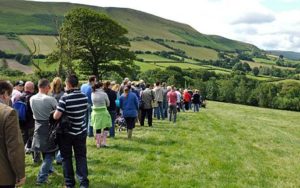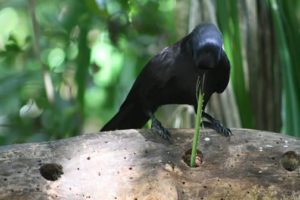Cultural traditions are common in humans and are thought to be rooted in our evolutionary history; they are deeply ingrained in our society and can, under certain conditions, result in non-adaptive behavior.

Given this, might one also expect to observe evidence of cultural traditions in non-human animals? But how do we look for “culture” in animals? For a behavior to be considered a cultural phenomenon it needs to be performed by multiple group members, it must vary between communities but there must also be the potential for the same behavior to be exhibited by those other communities.
By that definition, culture is not a uniquely human trait and cultural traditions have been observed in wild apes. For example, one community of chimpanzees in Kibale Forest use sticks to access honey from a fallen log, and chimpanzees from Budongo Forest used leaf sponges in order to access the honey.
One would expect to see more cultural practices in the transmission of complex behaviors rather than simple behaviors which are easy to learn individually. Thus, tool use is an ideal candidate to investigate social transmission of behavior—that is behavior which is not learned anew by an individual on his or her own, but is copies from others in the community.
New Caledonian crows are endemic to the islands of New Caledonia in the Pacific and display remarkably sophisticated tool using behavior. They are able to make tools from material that they have never encountered before and naturally use tools to access various types of food. They can shape pandanus leaves into step-like tools to access grubs from tree trunks. Crucially their tool types vary across geographic range and it is currently unclear what causes this variation.
It has been suggested that this variation is the result of social transmission within groups and that birds socially learn how to make the tools; thus it would be a sign of cultural differences between the groups. However, the variation may also be the result of genetic predispositions which differ between the groups. Finally, it may also be the result of differences in local ecology which could result from asocial learning about what makes a good tool.

These hypotheses are difficult to tease apart in a tool use task as it would require translocating wild birds to different areas and examining the impact on their tool using behavior. An alternative solution is to investigate how the acquisition of a novel behavior (accessing food in different ways from an apparatus) spreads through a group. This would reveal whether New Caledonian crows are capable of the complex social learning which would be required for cultural transmission of tool use behaviour.
A recent paper published in the Psychonomic Society’s journal Learning and Behavior from researchers at the universities of Cambridge, St Andrews, Auckland and Anglia Ruskin has tested exactly that. Researcher Corina Logan presented three groups of crows with apparatuses containing a food reward. Each apparatus could be accessed in four different ways at three different locations.
Two demonstrator birds (one from each experimental group) were trained to access food at a specific location and in a specific way; this was different for each bird. Two versions of the apparatus were then put into the aviary and all birds within the group could access the food. The design allowed the researchers to investigate what the birds were learning from observing the demonstration. Did they simply learn about the specific place that the demonstrator was getting access to the food, or did they learn about how the demonstrator was getting food, the specific actions required to access it? The third group, a control group, simply got access to the apparatuses and the researchers monitored how they would naturally access the food without seeing a demonstration from another individual. The apparatuses were placed in the aviary with all the group present so that the spread of the behaviours throughout the groups could be observed.
The results revealed that the birds socially learned about the position that a bird was using to access food, but they did not learn about the action that the demonstrator was performing.
The results thus did not demonstrate the sophisticated social learning skills, such as imitation, which are likely to result in the social transmission of knowledge about tool making. Rather, the birds went to the area where another bird had been foraging, the authors suggest that this sort of local or positional enhancement may influence the birds foraging behavior. Thus, they may be attracted to a specific area because of the presence of the other birds and then learn individually about the local ecology: It is therefore possible that the birds learn about tool types from observing discarded tools which are in the area.
